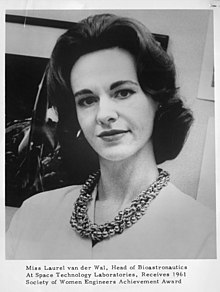Bioastronautics
This article includes a list of references, related reading, or external links, but its sources remain unclear because it lacks inline citations. (April 2013) |


Bioastronautics is a specialty area of biological and astronautical research which encompasses numerous aspects of biological, behavioral, and medical concern governing humans and other living organisms in outer space; and includes the design of space vehicle payloads, space habitats, and life-support systems. In short, it spans the study and support of life in space.
Bioastronautics includes many similarities with its sister discipline astronautical hygiene; they both study the hazards that humans may encounter during a space flight. However, astronautical hygiene differs in many respects e.g. in this discipline, once a hazard is identified, the exposure risks are then assessed and the most effective measures determined to prevent or control exposure and thereby protect the health of the astronaut. Astronautical hygiene is an applied scientific discipline that requires knowledge and experience of many fields including bioastronautics, space medicine, ergonomics etc. The skills of astronautical hygiene are already being applied for example, to characterise Moon dust and design the measures to mitigate exposure during lunar exploration, to develop accurate chemical monitoring techniques and use the results in the setting SMACs.
Of particular interest from a biological perspective are the effects of reduced gravitational force felt by inhabitants of spacecraft. Often referred to as "microgravity", the lack of sedimentation, buoyancy, or convective flows in fluids results in a more quiescent cellular and intercellular environment primarily driven by chemical gradients. Certain functions of organisms are mediated by gravity, such as gravitropism in plant roots and negative gravitropism in plant stems, and without this stimulus growth patterns of organisms onboard spacecraft often diverge from their terrestrial counterparts. Additionally, metabolic energy normally expended in overcoming the force of gravity remains available for other functions. This may take the form of accelerated growth in organisms as diverse as worms like C. elegans to miniature parasitoid wasps such as Spangia endius. It may also be used in the augmented production of secondary metabolites such as the vinca alkaloids Vincristine and Vinblastine in the rosy periwinkle (Catharanthus roseus), whereby space grown specimens often have higher concentrations of these constituents that on earth are present in only trace amounts.[1]
Engineering considerations
[edit]From an engineering perspective, facilitating the delivery and exchange of air, food, and water, and the processing of waste products is also challenging. The transition from expendable physicochemical methods to sustainable bioregenerative systems that function as a robust miniature ecosystem is another goal of bioastronautics in facilitating long duration space travel. Such systems are often termed Closed Ecological Life Support Systems (CELSS).
Medical considerations
[edit]From a medical perspective, long duration space flight also has physiological impacts on astronauts. Accelerated bone decalcification, similar to osteopenia and osteoporosis on Earth, is just one such condition.[2] Another serious concern is the effects of space travel upon the kidneys. Current estimates of these effects upon the kidneys indicates that unless some kind of effective additional remedial technology against kidney damage is employed, astronauts who have been exposed to micro-gravity, reduced gravity, and Galactic radiation for 3 years or so on a Mars mission may have to return to Earth while attached to dialysis machines.[3] The study of the potential effects of space travel is useful not only for advancing methods of the safe habitation of space, and the travel through space, but also in uncovering ways to more effectively treat closely related terrestrial ailments.
NASA's Bioastronautics library
[edit]NASA's Johnson Space Center in Houston, Texas maintains a Bioastronautics Library. The one-room facility provides a collection of textbooks, reference books, conference proceedings, and academic journals related to bioastronautics topics.[4] Because the library is located within secure government property (not part of Space Center Houston, the official visitors center of JSC), it is not generally accessible to the public.
See also
[edit]- Effect of spaceflight on the human body
- Life support system
- Space habitation
- Locomotion in space
- Reduced muscle mass, strength and performance in space
- Space food
- Astronautical hygiene
- Spaceflight radiation carcinogenesis
- Space medicine
- Sex in space
- Space tourism
- Space-based economy
- List of spaceflight-related accidents and incidents
- Writing in space
- Space art#Art in space
- Religion in space
- Organisms at high altitude
- Astrobiology
- Astrobotany
- Plants in space
References
[edit]- ^ Stodieck, Louis S.; Hoehn, Alex; Heyenga, A. Gerard (1998). "Space flight research leading to the development of enhanced plant products: Results from STS-94". AIP Conference Proceedings. 420: 578–585. Bibcode:1998AIPC..420..578S. doi:10.1063/1.54909. ISSN 0094-243X.
- ^ Graebe, Annemarie; Schuck, Edgar L.; Lensing, Petra; Putcha, Lakshmi; Derendorf, Hartmut (2004). "Physiological, Pharmacokinetic, and Pharmacodynamic Changes in Space". The Journal of Clinical Pharmacology. 44 (8): 837–853. doi:10.1177/0091270004267193. ISSN 0091-2700. PMID 15286087. S2CID 7861059.
- ^ Any Trip to Mars Might Destroy Astronaut's Kidneys: Study US News. By HealthDay. June 12, 2024. Retrieved June 18, 2024.
- ^ Duggan, Clay. "STI Center resources still available to employees following move to UHCL".
External links
[edit]- Harvard-MIT Health Sciences and Technology - Bioastronautics Training Program (HST-Bioastro) [1]
- NASA's Bioastronautics Roadmap [2]
- University of Colorado at Boulder Bioastronautics Research Group [3]
- The American Society for Gravitational and Space Biology (ASGSB) [4] Archived 2008-09-12 at the Wayback Machine
- 1965 radio series titled Their Other World, 13 half-hour episodes with typed transcript [5].


 French
French Deutsch
Deutsch